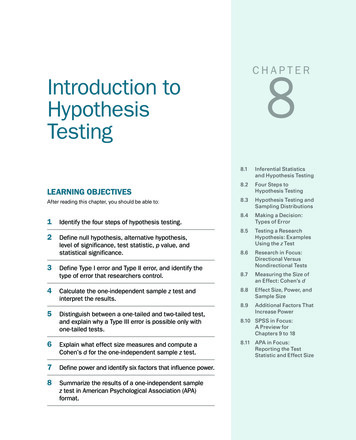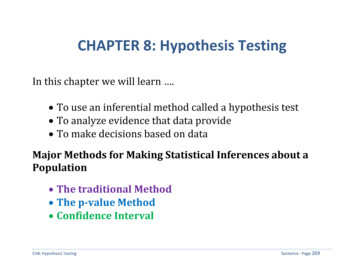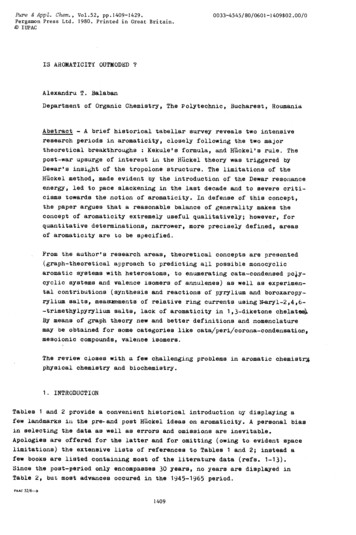
Transcription
CHAPTER8Introduction toHypothesisTestingLEARNING OBJECTIVESAfter reading this chapter, you should be able to:1Identify the four steps of hypothesis testing.2Define null hypothesis, alternative hypothesis,level of significance, test statistic, p value, andstatistical significance.3Define Type I error and Type II error, and identify thetype of error that researchers control.4Calculate the one-independent sample z test andinterpret the results.5Distinguish between a one-tailed and two-tailed test,and explain why a Type III error is possible only withone-tailed tests.6Explain what effect size measures and compute aCohen’s d for the one-independent sample z test.7Define power and identify six factors that influence power.8Summarize the results of a one-independent samplez test in American Psychological Association (APA)format.8.1Inferential Statisticsand Hypothesis Testing8.2Four Steps toHypothesis Testing8.3Hypothesis Testing andSampling Distributions8.4Making a Decision:Types of Error8.5Testing a ResearchHypothesis: ExamplesUsing the z Test8.6Research in Focus:Directional VersusNondirectional Tests8.7Measuring the Size ofan Effect: Cohen’s d8.8Effect Size, Power, andSample Size8.9Additional Factors ThatIncrease Power8.10 SPSS in Focus:A Preview forChapters 9 to 188.11 APA in Focus:Reporting the TestStatistic and Effect Size
28.1PART III: PROBABILITY AND THE FOUNDATIONS OF INFERENTIAL STATISTICSINFERENTIAL STATISTICS AND HYPOTHESIS TESTINGWe use inferential statistics because it allows us to measure behavior in samples tolearn more about the behavior in populations that are often too large or inaccessi ble. We use samples because we know how they are related to populations. Forexample, suppose the average score on a standardized exam in a given population is1,000. In Chapter 7, we showed that the sample mean as an unbiased estimator ofthe population mean—if we selected a random sample from a population, then onaverage the value of the sample mean will equal the population mean. In our exam ple, if we select a random sample from this population with a mean of 1,000, thenon average, the value of a sample mean will equal 1,000. On the basis of the centrallimit theorem, we know that the probability of selecting any other sample meanvalue from this population is normally distributed.In behavioral research, we select samples to learn more about populations ofinterest to us. In terms of the mean, we measure a sample mean to learn more aboutthe mean in a population. Therefore, we will use the sample mean to describe thepopulation mean. We begin by stating the value of a population mean, and then weselect a sample and measure the mean in that sample. On average, the value of thesample mean will equal the population mean. The larger the difference or discrep ancy between the sample mean and population mean, the less likely it is that wecould have selected that sample mean, if the value of the population mean is cor rect. This type of experimental situation, using the example of standardized examscores, is illustrated in Figure 8.1.FIGURE 8.1The sampling distribution for apopulation mean is equal to 1,000.If 1,000 is the correct populationmean, then we know that, onaverage, the sample mean willequal 1,000 (the population mean).Using the empirical rule, we knowthat about 95% of all samplesselected from this population willhave a sample mean that fallswithin two standard deviations(SD) of the mean. It is thereforeunlikely (less than a 5%probability) that we will measure asample mean beyond2 SD from the population mean, ifthe population mean is indeedcorrect.We expect thesample mean to beequal to thepopulation mean.µ 1000The method in which we select samples to learn more about characteristics ina given population is called hypothesis testing. Hypothesis testing is really asystematic way to test claims or ideas about a group or population. To illustrate,
C H APT ER 8 : I N T RO D U C T I O N T O H YPO T H ES I S T ES T I NG3suppose we read an article stating that children in the United States watch an aver age of 3 hours of TV per week. To test whether this claim is true, we record the time(in hours) that a group of 20 American children (the sample), among all children inthe United States (the population), watch TV. The mean we measure for these 20children is a sample mean. We can then compare the sample mean we select to thepopulation mean stated in the article.Hypothesis testing or significance testing is a method for testing a claim orhypothesis about a parameter in a population, using data measured in asample. In this method, we test some hypothesis by determining thelikelihood that a sample statistic could have been selected, if the hypothesisregarding the population parameter were true.DEFINITIONThe method of hypothesis testing can be summarized in four steps. We willdescribe each of these four steps in greater detail in Section 8.2.1. To begin, we identify a hypothesis or claim that we feel should be tested.For example, we might want to test the claim that the mean number ofhours that children in the United States watch TV is 3 hours.2. We select a criterion upon which we decide that the claim being tested istrue or not. For example, the claim is that children watch 3 hours of TV perweek. Most samples we select should have a mean close to or equal to3 hours if the claim we are testing is true. So at what point do we decide thatthe discrepancy between the sample mean and 3 is so big that the claimwe are testing is likely not true? We answer this question in this step ofhypothesis testing.3. Select a random sample from the population and measure the sample mean.For example, we could select 20 children and measure the mean time (inhours) that they watch TV per week.4. Compare what we observe in the sample to what we expect to observe ifthe claim we are testing is true. We expect the sample mean to be around3 hours. If the discrepancy between the sample mean and population meanis small, then we will likely decide that the claim we are testing is indeedtrue. If the discrepancy is too large, then we will likely decide to reject theclaim as being not true.1.On average, what do we expect the sample mean to be equal to?2.True or false: Researchers select a sample from a population to learn more aboutcharacteristics in that sample.NOTE: Hypothesis testing isthe method of testing whetherclaims or hypotheses regardinga population are likely to betrue.LE A R N I N GC H EC K 1characteristics in the population that the sample was selected from.Answers: 1. The population mean; 2. False. Researchers select a sample from a population to learn more about
4PART III: PROBABILITY AND THE FOUNDATIONS OF INFERENTIAL STATISTICS8.2FOUR STEPS TO HYPOTHESIS TESTINGThe goal of hypothesis testing is to determine the likelihood that a populationparameter, such as the mean, is likely to be true. In this section, we describe the foursteps of hypothesis testing that were briefly introduced in Section 8.1:Step 1: State the hypotheses.Step 2: Set the criteria for a decision.Step 3: Compute the test statistic.Step 4: Make a decision.Step 1: State the hypotheses. We begin by stating the value of a population meanin a null hypothesis, which we presume is true. For the children watching TVexample, we state the null hypothesis that children in the United States watch anaverage of 3 hours of TV per week. This is a starting point so that we can decidewhether this is likely to be true, similar to the presumption of innocence in acourtroom. When a defendant is on trial, the jury starts by assuming that thedefendant is innocent. The basis of the decision is to determine whether thisassumption is true. Likewise, in hypothesis testing, we start by assuming that thehypothesis or claim we are testing is true. This is stated in the null hypothesis. Thebasis of the decision is to determine whether this assumption is likely to be true.DEFINITIONNOTE: In hypothesis testing,we conduct a study to testwhether the null hypothesis islikely to be true.DEFINITIONThe null hypothesis (H0), stated as the null, is a statement about a populationparameter, such as the population mean, that is assumed to be true.The null hypothesis is a starting point. We will test whether the valuestated in the null hypothesis is likely to be true.Keep in mind that the only reason we are testing the null hypothesis is becausewe think it is wrong. We state what we think is wrong about the null hypothesis inan alternative hypothesis. For the children watching TV example, we may havereason to believe that children watch more than ( ) or less than ( ) 3 hours of TVper week. When we are uncertain of the direction, we can state that the value in thenull hypothesis is not equal to ( ) 3 hours.In a courtroom, since the defendant is assumed to be innocent (this is the nullhypothesis so to speak), the burden is on a prosecutor to conduct a trial to showevidence that the defendant is not innocent. In a similar way, we assume the nullhypothesis is true, placing the burden on the researcher to conduct a study to showevidence that the null hypothesis is unlikely to be true. Regardless, we always makea decision about the null hypothesis (that it is likely or unlikely to be true). Thealternative hypothesis is needed for Step 2.An alternative hypothesis (H1) is a statement that directly contradicts a nullhypothesis by stating that that the actual value of a population parameter isless than, greater than, or not equal to the value stated in the null hypothesis.The alternative hypothesis states what we think is wrong about the nullhypothesis, which is needed for Step 2.
C H APT ER 8 : I N T RO D U C T I O N T O H YPO T H ES I S T ES T I NGMAKING SENSE: Testing the Null HypothesisA decision made in hypothesis testing centers on the null hypothesis. Thismeans two things in terms of making a decision:1. Decisions are made about the null hypothesis. Using the courtroomanalogy, a jury decides whether a defendant is guilty or not guilty. Thejury does not make a decision of guilty or innocent because the defendantis assumed to be innocent. All evidence presented in a trial is to showthat a defendant is guilty. The evidence either shows guilt (decision:guilty) or does not (decision: not guilty). In a similar way, the nullhypothesis is assumed to be correct. A researcher conducts a study show ing evidence that this assumption is unlikely (we reject the null hypoth esis) or fails to do so (we retain the null hypothesis).2. The bias is to do nothing. Using the courtroom analogy, for the samereason the courts would rather let the guilty go free than send the inno cent to prison, researchers would rather do nothing (accept previousnotions of truth stated by a null hypothesis) than make statements thatare not correct. For this reason, we assume the null hypothesis is correct,thereby placing the burden on the researcher to demonstrate that thenull hypothesis is not likely to be correct.Step 2: Set the criteria for a decision. To set the criteria for a decision, we state thelevel of significance for a test. This is similar to the criterion that jurors use in acriminal trial. Jurors decide whether the evidence presented shows guilt beyond areasonable doubt (this is the criterion). Likewise, in hypothesis testing, we collectdata to show that the null hypothesis is not true, based on the likelihood of selectinga sample mean from a population (the likelihood is the criterion). The likelihood orlevel of significance is typically set at 5% in behavioral research studies. When theprobability of obtaining a sample mean is less than 5% if the null hypothesis weretrue, then we conclude that the sample we selected is too unlikely and so we rejectthe null hypothesis.Level of significance, or significance level, refers to a criterion of judgmentupon which a decision is made regarding the value stated in a null hypothesis.The criterion is based on the probability of obtaining a statistic measured in asample if the value stated in the null hypothesis were true.In behavioral science, the criterion or level of significance is typically set at5%. When the probability of obtaining a sample mean is less than 5% if thenull hypothesis were true, then we reject the value stated in the nullhypothesis.The alternative hypothesis establishes where to place the level of significance.Remember that we know that the sample mean will equal the population mean onaverage if the null hypothesis is true. All other possible values of the sample meanare normally distributed (central limit theorem). The empirical rule tells us that atleast 95% of all sample means fall within about 2 standard deviations (SD) of thepopulation mean, meaning that there is less than a 5% probability of obtaining aDEFINITION5
6PART III: PROBABILITY AND THE FOUNDATIONS OF INFERENTIAL STATISTICSWe expect thesample mean to beequal to thepopulation mean.H1: Childrenwatch less than3 hours of TVper week.H1: Childrenwatch morethan 3 hours ofTV per week.µ 3µ 3FIGURE 8.2The alternative hypothesisdetermines whether to placethe level of significance in oneor both tails of a samplingdistribution. Sample meansthat fall in the tails areunlikely to occur (less than a5% probability) if the valuestated for a population meanin the null hypothesis is true.µ 3H1: Childrendo not watch3 hours ofTV per week.sample mean that is beyond 2 SD from the population mean. For the childrenwatching TV example, we can look for the probability of obtaining a sample meanbeyond 2 SD in the upper tail (greater than 3), the lower tail (less than 3), or bothtails (not equal to 3). Figure 8.2 shows that the alternative hypothesis is used todetermine which tail or tails to place the level of significance for a hypothesis test.NOTE: The level ofsignificance in hypothesistesting is the criterion weuse to decide whether thevalue stated in the nullhypothesis is likely to be true.DEFINITIONNOTE: We use the value of thetest statistic to make a decisionregarding the null hypothesis.Step 3: Compute the test statistic. Suppose we measure a sample mean equal to4 hours per week that children watch TV. To make a decision, we need to evaluatehow likely this sample outcome is, if the population mean stated by the nullhypothesis (3 hours per week) is true. We use a test statistic to determine thislikelihood. Specifically, a test statistic tells us how far, or how many standarddeviations, a sample mean is from the population mean. The larger the value of thetest statistic, the further the distance, or number of standard deviations, a samplemean is from the population mean stated in the null hypothesis. The value of thetest statistic is used to make a decision in Step 4.The test statistic is a mathematical formula that allows researchers todetermine the likelihood of obtaining sample outcomes if the null hypothesiswere true. The value of the test statistic is used to make a decision regardingthe null hypothesis.Step 4: Make a decision. We use the value of the test statistic to make a decisionabout the null hypothesis. The decision is based on the probability of obtaining asample mean, given that the value stated in the null hypothesis is true. If the
C H APT ER 8 : I N T RO D U C T I O N T O H YPO T H ES I S T ES T I NGprobability of obtaining a sample mean is less than 5% when the null hypothesis istrue, then the decision is to reject the null hypothesis. If the probability of obtaininga sample mean is greater than 5% when the null hypothesis is true, then thedecision is to retain the null hypothesis. In sum, there are two decisions a researchercan make:1. Reject the null hypothesis. The sample mean is associated with a low proba bility of occurrence when the null hypothesis is true.2. Retain the null hypothesis. The sample mean is associated with a high proba bility of occurrence when the null hypothesis is true.The probability of obtaining a sample mean, given that the value stated in thenull hypothesis is true, is stated by the p value. The p value is a probability: It variesbetween 0 and 1 and can never be negative. In Step 2, we stated the criterion orprobability of obtaining a sample mean at which point we will decide to reject thevalue stated in the null hypothesis, which is typically set at 5% in behavioral research.To make a decision, we compare the p value to the criterion we set in Step 2.A p value is the probability of obtaining a sample outcome, given that thevalue stated in the null hypothesis is true. The p value for obtaining a sampleoutcome is compared to the level of significance.DEFINITIONSignificance, or statistical significance, describes a decision made concerning avalue stated in the null hypothesis. When the null hypothesis is rejected, we reachsignificance. When the null hypothesis is retained, we fail to reach significance.When the p value is less than 5% (p .05), we reject the null hypothesis. We willrefer to p .05 as the criterion for deciding to reject the null hypothesis, althoughnote that when p .05, the decision is also to reject the null hypothesis. When thep value is greater than 5% (p .05), we retain the null hypothesis. The decision toreject or retain the null hypothesis is called significance. When the p value is lessthan .05, we reach significance; the decision is to reject the null hypothesis. Whenthe p value is greater than .05, we fail to reach significance; the decision is to retainthe null hypothesis. Figure 8.3 shows the four steps of hypothesis testing.NOTE: Researchers makedecisions regarding the nullhypothesis. The decision canbe to retain the null (p .05)or reject the null (p .05).LE A R N I N GC H EC K 21.State the four steps of hypothesis testing.2.The decision in hypothesis testing is to retain or reject which hypothesis: thenull or alternative hypothesis?3.The criterion or level of significance in behavioral research is typically set atwhat probability value?4.A test statistic is associated with a p value less than .05 or 5%. What is the deci sion for this hypothesis test?5.If the null hypothesis is rejected, then did we reach significance?7outcome; 4. Reject the null; 5. Yes.Step 3: Compute the test statistic. Step 4: Make a decision; 2. Null; 3. A .05 or 5% likelihood for obtaining a sampleAnswers: 1. Step 1: State the null and alternative hypothesis. Step 2: Determine the level of significance.
8PART III: PROBABILITY AND THE FOUNDATIONS OF INFERENTIAL STATISTICSSTEP 1: State the hypotheses.A researcher states a nullhypothesis about a value in thepopulation (H0) and analternative hypothesis thatcontradicts the null hypothesis.STEP 2: Set the criteria for adecision. A criterion is set uponwhich a researcher will decidewhether to retain or reject thevalue stated in the ------------------------Level of Significance -----------A sample is selected from thepopulation, and a sample meanis measured.Conduct a studywith a sampleselected from apopulation.STEP 3: Compute the teststatistic. This will produce avalue that can be compared tothe criterion that was set beforethe sample was selected.Measure dataand computea test statistic.STEP 4: Make a decision.If the probability of obtaining asample mean is less than 5%when the null is true, then rejectthe null hypothesis.If the probability of obtaining asample mean is greater than 5%when the null is true, thenretain the null hypothesis.FIGURE 8.3A summary of hypothesis testing.8.3 HYPOTHESIS TESTING ANDSAMPLING DISTRIBUTIONSThe logic of hypothesis testing is rooted in an understanding of the samplingdistribution of the mean. In Chapter 7, we showed three characteristics of themean, two of which are particularly relevant in this section:1. The sample mean is an unbiased estimator of the population mean. Onaverage, a randomly selected sample will have a mean equal to that in thepopulation. In hypothesis testing, we begin by stating the null hypothesis.We expect that, if the null hypothesis is true, then a random sample selectedfrom a given population will have a sample mean equal to the value statedin the null hypothesis.2. Regardless of the distribution in the population, the sampling distributionof the sample mean is normally distributed. Hence, the probabilities of allother possible sample means we could select are normally distributed. Usingthis distribution, we can therefore state an alternative hypothesis to locatethe probability of obtaining sample means with less than a 5% chance ofbeing selected if the value stated in the null hypothesis is true. Figure 8.2shows that we can identify sample mean outcomes in one or both tails.
C H APT ER 8 : I N T RO D U C T I O N T O H YPO T H ES I S T ES T I NGTo locate the probability of obtaining a sample mean in a sampling distribution,we must know (1) the population mean and (2) the standard error of the mean(SEM; introduced in Chapter 7). Each value is entered in the test statistic formulacomputed in Step 3, thereby allowing us to make a decision in Step 4. To review,Table 8.1 displays the notations used to describe populations, samples, and samplingdistributions. Table 8.2 summarizes the characteristics of each type of distribution.TABLE 8.1 A review of the notation used for the mean, variance, and standard deviation in population,sample, and sampling ��M or XVariances2s2 or SD 2Standarddeviationss or SDSampling DistributionmM m2σM σM σ2nσnTABLE 8.2 A review of the key differences between population, sample, and sampling distributions.1.Population DistributionSample DistributionDistribution of Sample MeansWhat is it?Scores of all persons in apopulationScores of a selectportion of persons fromthe populationAll possible sample means thatcan be drawn, given a certainsample sizeIs it accessible?Typically, noYesYesWhat is the shape?Could be any shapeCould be any shapeNormally distributedFor the following statement, write increases or decreases as an answer. The like lihood that we reject the null hypothesis (increases or decreases):a. The closer the value of a sample mean is to the value stated by the nullhypothesis?b. The further the value of a sample mean is from the value stated in the nullhypothesis?A researcher selects a sample of 49 students to test the null hypothesis that theaverage student exercises 90 minutes per week. What is the mean for the sam pling distribution for this population of interest if the null hypothesis is true?Answers: 1. (a) Decreases, (b) Increases; 2. 90 minutes.2.LE A R N I N GC H EC K 39
108.4PART III: PROBABILITY AND THE FOUNDATIONS OF INFERENTIAL STATISTICSMAKING A DECISION: TYPES OF ERRORIn Step 4, we decide whether to retain or reject the null hypothesis. Because we areobserving a sample and not an entire population, it is possible that a conclusionmay be wrong. Table 8.3 shows that there are four decision alternatives regardingthe truth and falsity of the decision we make about a null hypothesis:1. The decision to retain the null hypothesis could be correct.2. The decision to retain the null hypothesis could be incorrect.3. The decision to reject the null hypothesis could be correct.4. The decision to reject the null hypothesis could be incorrect.TABLE 8.3 Four outcomes for making a decision. The decision can be either correct (correctly rejector retain null) or wrong (incorrectly reject or retain null).DecisionTrueTruth in thepopulation FalseRetain the nullReject the nullCORRECT1–aTYPE I ERRORaTYPE II ERRORbCORRECT1–bPOWERWe investigate each decision alternative in this section. Since we will observe asample, and not a population, it is impossible to know for sure the truth in thepopulation. So for the sake of illustration, we will assume we know this. Thisassumption is labeled as truth in the population in Table 8.3. In this section, we willintroduce each decision alternative.DECISION: RETAIN THE NULL HYPOTHESISWhen we decide to retain the null hypothesis, we can be correct or incorrect. Thecorrect decision is to retain a true null hypothesis. This decision is called a nullresult or null finding. This is usually an uninteresting decision because the deci sion is to retain what we already assumed: that the value stated in the null hypoth esis is correct. For this reason, null results alone are rarely published in behavioralresearch.The incorrect decision is to retain a false null hypothesis. This decision is anexample of a Type II error, or b error. With each test we make, there is alwayssome probability that the decision could be a Type II error. In this decision, wedecide to retain previous notions of truth that are in fact false. While it’s an error,we still did nothing; we retained the null hypothesis. We can always go back andconduct more studies.
C H APT ER 8 : I N T RO D U C T I O N T O H YPO T H ES I S T ES T I NGType II error, or beta (b) error, is the probability of retaining a null hypothesisthat is actually false.DECISION: REJECT THE NULL HYPOTHESISWhen we decide to reject the null hypothesis, we can be correct or incorrect. Theincorrect decision is to reject a true null hypothesis. This decision is an example of aType I error. With each test we make, there is always some probability that ourdecision is a Type I error. A researcher who makes this error decides to reject previ ous notions of truth that are in fact true. Making this type of error is analogous tofinding an innocent person guilty. To minimize this error, we assume a defendant isinnocent when beginning a trial. Similarly, to minimize making a Type I error, weassume the null hypothesis is true when beginning a hypothesis test.Type I error is the probability of rejecting a null hypothesis that is actually true.Researchers directly control for the probability of committing this type of error.11DEFINITIONNOTE: A Type II error, or beta(b) error, is the probability ofincorrectly retaining the nullhypothesis.DEFINITIONAn alpha (a) level is the level of significance or criterion for a hypothesis test.It is the largest probability of committing a Type I error that we will allow andstill decide to reject the null hypothesis.Since we assume the null hypothesis is true, we control for Type I error by stating alevel of significance. The level we set, called the alpha level (symbolized as a), is the larg est probability of committing a Type I error that we will allow and still decide to reject thenull hypothesis. This criterion is usually set at .05 (a .05), and we compare the alphalevel to the p value. When the probability of a Type I error is less than 5% (p .05),we decide to reject the null hypothesis; otherwise, we retain the null hypothesis.The correct decision is to reject a false null hypothesis. There is always someprobability that we decide that the null hypothesis is false when it is indeed false. Thisdecision is called the power of the decision-making process. It is called power becauseit is the decision we aim for. Remember that we are only testing the null hypothesisbecause we think it is wrong. Deciding to reject a false null hypothesis, then, is thepower, inasmuch as we learn the most about populations when we accurately rejectfalse notions of truth. This decision is the most published result in behavioral research.The power in hypothesis testing is the probability of rejecting a false nullhypothesis. Specifically, it is the probability that a randomly selected sample willshow that the null hypothesis is false when the null hypothesis is indeed false.1.What type of error do we directly control?2.What type of error is associated with decisions to retain the null?3.What type of error is associated with decisions to reject the null?4.State the two correct decisions that a researcher can make.NOTE: Researchers directlycontrol for the probability ofa Type I error by stating analpha (a) level.NOTE: The power in hypothesistesting is the probability ofcorrectly rejecting the valuestated in the null hypothesis.DEFINITIONLE A R N I N GC H EC K 4hypothesis.Answers: 1. Type I error; 2. Type II error; 3. Type I error; 4. Retain a true null hypothesis and reject a false null
12PART III: PROBABILITY AND THE FOUNDATIONS OF INFERENTIAL STATISTICS8.5 TESTING A RESEARCH HYPOTHESIS:EXAMPLES USING THE Z TESTThe test statistic in Step 3 converts the sampling distribution we observe into astandard normal distribution, thereby allowing us to make a decision in Step 4. Thetest statistic we use depends largely on what we know about the population. Whenwe know the mean and standard deviation in a single population, we can use theone–independent sample z test, which we will use in this section to illustratethe four steps of hypothesis testing.DEFINITIONNOTE: The z test is used totest hypotheses about apopulation mean when thepopulation variance is known.The one–independent sample z test is a statistical procedure used to testhypotheses concerning the mean in a single population with a known variance.Recall that we can state one of three alternative hypotheses: A population meanis greater than ( ), less than ( ), or not equal ( ) to the value stated in a null hypoth esis. The alternative hypothesis determines which tail of a sampling distribution toplace the level of significance, as illustrated in Figure 8.2. In this section, we will usean example for each type of alternative hypothesis.NONDIRECTIONAL, TWO-TAILEDHYPOTHESIS TESTS (H1: )NOTE: Nondirectionaltests are used to testhypotheses when we areinterested in any alternativefrom the null hypothesis.DEFINITIONE X A M PL E 8 .1In Example 8.1, we will use the z test for a nondirectional, or two-tailed test,where the alternative hypothesis is stated as not equal to ( ) the null hypothesis. Forthis test, we will place the level of significance in both tails of the sampling distribu tion. We are therefore interested in any alternative from the null hypothesis. This isthe most co
Keep in mind that the only reason we are testing the null hypothesis is because we think it is wrong. We state what we think is wrong about the null hypothesis in an alternative hypothesis. For the children watching TV example, we may have reason to believe that children watch mor










